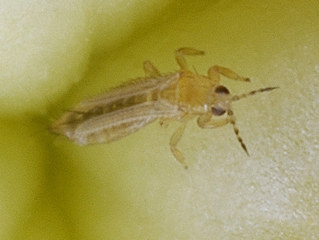Spread of viruses in greenhouses
There are various ways viruses can spread throughout the greenhouse. Transmission or method of spreading depends on the virus genes. A virus cannot move from one plant to another by themselves. They must be transmitted by a vector or another organism, most of the time they are insects. Each virus will have a very specific host through which it spreads.
Some types can be spread via contact between people and plant. TMV and odontoglossum ringspot are transferred to other plants by contact with people, implements, vehicles and clothing. They can survive long periods outside the plant tissue.
Pollen is a source for virus infection. Although the mother plant does not show any symptoms, the seedlings will be infected. Virus spread through seed is small. Only 16.7% of the TMV virus spread through tomato seed.1)Ismaeil, Faiz & Kasem, A.A. & Al-Chaabi, S.. (2011). Distribution and Seed Transmission of Tomato mosaic virus on Tomato and Pepper Crops in Syria.. 29. 21-28. The virus can survive for years in seeds so their seedlings will be infected by the virus.
Tomato mosaic virus can also spread through the nutrient solution of a hydroponic system. They can survive for six months in the water.2)Pares, R. & Gunn, L. & Cresswell, Geoff. (2008). Tomato Mosaic Virus Infection in a Recirculating Nutrient Solution. Journal of Phytopathology. 135. 192 – 198.
Pruning shears are a big source and spread of viruses. It has been found that ToMV transmission was not significantly reduced when the pruning shears were treated with 0.01% Ivory Liquid, sterile deionized water, or 70% ethanol.3)Pategas, Kristen & Schuerger, Andrew & Wetter, CArl. (1989). Management of Tomato Mosaic Virus in Hydroponically Grown Pepper (Capsicum annuum). Plant Disease. 73. 570-573. 10.1094/PD-73-0570. Most viruses require at least 90% ethanol before they are eliminated.
Yamasaki et al (2012)4)Yamasaki, S., Okazaki, S. & Okuda, M. Temporal and spatial dispersal of Melon yellow spot virus in cucumber greenhouses and evaluation of weeds as infection sources. Eur J Plant Pathol 132, 169–177 (2012). showed that weed control is important for managing Melon yellow spot virus (MYSV) since weeds provide a habitat for the vector thrips and also serve as an initial inoculum source of the virus. It is not only te weeds inside the greenhouse, but the weeds surrounding the greenhouses and the direction of the wind. The closer weeds are the greater the probability of virus infection.
Ehlers et al. (2023)5)Ehlers, Jens & Nourinejhad Zarghani, Shaheen & Liedtke, Stefanie & Kroschewski, Bärbel & Büttner, Carmen & Bandte, Martina. (2023). Analysis of the Spatial Dispersion of Tomato Brown Rugose Fruit Virus on Surfaces in a Commercial Tomato Production Site. 9. 611. 10.3390/horticulturae9050611. found that viruses are not limited to the production area alone. Significant infections were found away from the greenhouse in workers sleeping area. This means the infection point can be workers home and bringing fresh diseases in from outside the production area.
Transmission of viruses by vectors
Aphid transmission
Most plant viruses that infect plants are actually carried and spread by various types of aphids, those small insects you often find on your plants. Aphids are quite skilled at transmitting a wide range of plant viruses. Their ability to do this comes from their mouth parts, which are designed for piercing and sucking, allowing them to effectively pass on these viruses.
Aphids can spread viruses in a few different ways. They have non-persistent transmission, which means the virus doesn’t stick around for long. There’s also semi-persistent transmission, persistent transmission, and persistent propagative transmission. Most aphid species mainly spread viruses through non-persistent transmission or stylet-borne transmission.
Non-persistent transmission is the most common method of aphid transmission of viruses like potato virus Y, CMV, bean yellow mosaic and other viruses infecting bulbs. The green peach aphid, Myzus persicae is one of the most common vectors. A virus can infect an aphid under a minute. The aphid can then move to the next plant in a matter of seconds. Fortunately the virus is not retained by the aphid for long periods, usually less than a day. What makes transmission so effective is that low populations of aphids can still be very effective in spreading the virus. So infection can occur even though there are hardly any aphids on the plant.
Only a few viruses are passed on by aphids via persistent transmission. These viruses are picked up by the aphids when they feed for around 10 to 16 minutes or even longer. After this, there’s a bit of a waiting period, like an incubation time, which lasts for about 12 hours. It’s only after this wait that the aphid can actually transmit the virus to other plants. Surprisingly, the aphid can remain capable of transmitting the virus for at least a week, or even for its entire life.
This kind of transmission can also take place during longer feeding sessions, like those that last for an hour or more. However, to make this happen, the aphid usually has to settle down on the plant, although the virus doesn’t get passed down to its offspring.
Transmission of viruses by thrips
Thrips are specialized carriers of the TSWV, also known as “Kromnek” virus, which is among a tiny number of viruses. The main vectors of TSWV in South Africa are the onion and western flower thrips.
Only the larvae can receive the virus, and only after around 15 minutes. Temperature affects the latent period, which lasts between 4 and 10 days. Normally, it lasts long enough for only adults to transmit the infection. The virus is kept for the remainder of the insect’s life and transmission feeding can last as little as five minutes. However, it is not passed on to its offspring. Candice et al.(2011)6)Candice A. Stafford, Gregory P. Walker and Diane E. Ullman. Infection with a plant virus modifies vector feeding behavior. Proceedings of the National Academy of Sciences. Volume 108, Issue 23. Jun 2011., found that infected thrips feed up to three times more than uninfected thrips, thus increasing the chance for the virus to infect a plant.
White flies
The white fly Bemisia tabaci is gaining importance as a vector for viruses. The most common virus spread by white flies is tomato yellow leaf curl virus. At the moment the thread is not of economical importance, but climate change might have an effect later on. The white fly acquires the virus in 30minutes to four hours and they need at least 15 minutes to two hours to infect a plant after a latent period of sever hours. White flies remain infective for 5-25 days. According to Wintermantel (2004)7)Wintermantel, W.M. 2004. Emergence of Greenhouse Whitefly (Trialeurodes vaporariorum) Transmitted Criniviruses as Threats to Vegetable and Fruit Production in North America. APSnet Features., parasitic wasps of the genera Encarsia and Eretmocerus are the most widely used to control white fly over long periods in the US. If you control the host, you control the virus.
Nematodes
Nematodes such as Xiphenema, Longidorus, and Trichodorus, transmit nepo and tobra viruses. They are transmitted to the mouth parts of the nematode and are lost during moulting. It takes approximately 15–60 min for acquisition and transmission. Both larvae and adults can transmit a virus. It is interesting to note that most nematodes found in greenhouses are not found in field grown crops. The most common nematodes found in greenhouses are the tropical Meloidogyne species M. javanica, M. incognita, and M. hapla8)Eurofins Horti. Tropical nematodes in greenhouses. 5 November 2020. https://www.eurofins-horti.com/en/tropical-nematodes-in-horticulture..
Soil properties have just as big an effect on the distribution and type of nematoes found than the type of host. They found the presenc of nematode species of Meloidogyne(58.3%), Helicotylenchus(10.4%), and Pratylenchus (2.1%). Other species were less than 1%. This is helpful when selecting growth medium for various crops in greenhouses.9)Zhanar Tileubayeva, Aleksei Avdeenko, Svetlana Avdeenko, Natalia Stroiteleva, Sergey Kondrashev, Plant-parasitic nematodes affecting vegetable crops in greenhouses,Saudi Journal of Biological Sciences,Volume 28, Issue 9,2021,Pages 5428-5433,ISSN 1319-562X.
Fungi
Some fungi that infect roots also spread viruses. Olpidium spp. are the vectors of tobacco necrosis virus (TNV) and cucumber necrosis virus (CNV) as well as tobacco stunt and lettuce big vein disease. TNV and CNV are carried on the outside of the zoospores and thus are not retained for long. Other fungi get the virus while colonising the host internally. The virus is retained in resting spores and transmitted by zoospores.
References
| ↑1 | Ismaeil, Faiz & Kasem, A.A. & Al-Chaabi, S.. (2011). Distribution and Seed Transmission of Tomato mosaic virus on Tomato and Pepper Crops in Syria.. 29. 21-28. |
|---|---|
| ↑2 | Pares, R. & Gunn, L. & Cresswell, Geoff. (2008). Tomato Mosaic Virus Infection in a Recirculating Nutrient Solution. Journal of Phytopathology. 135. 192 – 198. |
| ↑3 | Pategas, Kristen & Schuerger, Andrew & Wetter, CArl. (1989). Management of Tomato Mosaic Virus in Hydroponically Grown Pepper (Capsicum annuum). Plant Disease. 73. 570-573. 10.1094/PD-73-0570. |
| ↑4 | Yamasaki, S., Okazaki, S. & Okuda, M. Temporal and spatial dispersal of Melon yellow spot virus in cucumber greenhouses and evaluation of weeds as infection sources. Eur J Plant Pathol 132, 169–177 (2012). |
| ↑5 | Ehlers, Jens & Nourinejhad Zarghani, Shaheen & Liedtke, Stefanie & Kroschewski, Bärbel & Büttner, Carmen & Bandte, Martina. (2023). Analysis of the Spatial Dispersion of Tomato Brown Rugose Fruit Virus on Surfaces in a Commercial Tomato Production Site. 9. 611. 10.3390/horticulturae9050611. |
| ↑6 | Candice A. Stafford, Gregory P. Walker and Diane E. Ullman. Infection with a plant virus modifies vector feeding behavior. Proceedings of the National Academy of Sciences. Volume 108, Issue 23. Jun 2011. |
| ↑7 | Wintermantel, W.M. 2004. Emergence of Greenhouse Whitefly (Trialeurodes vaporariorum) Transmitted Criniviruses as Threats to Vegetable and Fruit Production in North America. APSnet Features. |
| ↑8 | Eurofins Horti. Tropical nematodes in greenhouses. 5 November 2020. https://www.eurofins-horti.com/en/tropical-nematodes-in-horticulture. |
| ↑9 | Zhanar Tileubayeva, Aleksei Avdeenko, Svetlana Avdeenko, Natalia Stroiteleva, Sergey Kondrashev, Plant-parasitic nematodes affecting vegetable crops in greenhouses,Saudi Journal of Biological Sciences,Volume 28, Issue 9,2021,Pages 5428-5433,ISSN 1319-562X. |




